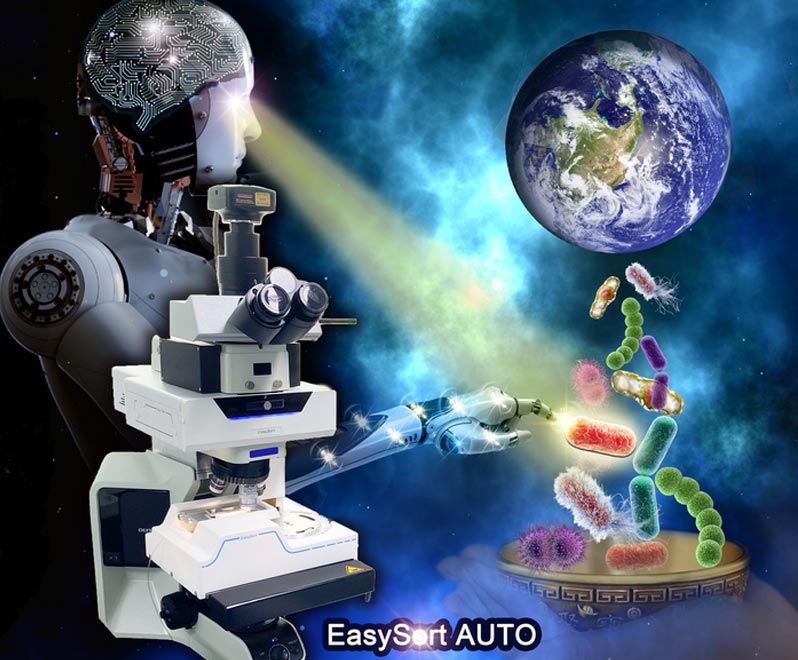

AI-assisted automated single-cell sorting and printing procedures using EasySort AUTO
Credit: LIU Yang
… and sorting of single bacterial cells.
The identification, sorting and export of single bacterial cells rather than just populations of them has long been incredibly complex, expensive and often just does not work without damaging the cells.
Now, researchers from the Qingdao Institute of Bioenergy and Bioprocess Technology (QIBEBT) of the Chinese Academy of Sciences (CAS) and their collaborators have proposed a new system called “EasySort AUTO” that allows single-cell analysis even of bacteria. It is based on artificial intelligence image recognition.
The study was published in mLife on Dec. 18.
Technologies that permit sorting and analysis of single cells generally employ fluorescence-activated cell sorting (FACS), which can sort a mixture of different biological cells into containers or tubes one cell at a time.
This works well for relatively large human cells from tissues or organs, but not for bacteria, which are typically about 1000 times smaller in volume. “Even when FACS is able to be performed on bacteria, in general, it is close to impossible to sort cells in an index-based fashion, particularly with the cell’s vitality preserved,” said DIAO Zhidian from Single-Cell Center of QIBEBT, first author of the study.
“It’s tricky and costly to sort bacteria, and even on those rare occasions when you manage it, you can’t do much with them anyway,” said KAN Lingyan, co-first author and an engineer at Single-Cell Center of QIBEBT.
As a result, microbiome research has remained trapped in relatively crude studies of cell populations. A simple to operate, low-cost, index-based and vitality-preserving single-cell sorting system is needed to work at the scale of bacteria and thus in turn allow single-cell analysis of microbiomes. For this, two key problems need to be solved. First, a cell detection and sorting method, and second, export of the tiny bacterial cells on a cell-by-cell basis to container tubes.
“For the first problem, we turned to artificial intelligence for its ability to detect even hidden properties of cells just from cell images, and thus for cell identification,” said ZHAO Yilong, co-first author at Single-Cell Center of QIBEBT.
“We deployed a deep convolutional neural network, a type of AI inspired by the visual cortex of animals and most often used for visual imagery identification,” said LI Yuandong, an engineer at Single-Cell Center of QIBEBT.
“For automation of the single-cell exporting to container tubes, we came up with a method that does not require any additional, complex equipment, but instead involves a capillary tube collection module coupled to an optical tweezer and positive-mount microscope platform,” said Prof. MA Bo, corresponding author from Single-Cell Center of QIBEBT, who led the study.
Target single-cells are identified by the image-based artificial intelligence algorithms, and are then moved from cell populations by the optical tweezers, followed by export to polymerase chain reaction (PCR) tubes through an automatic collection platform. During this process, a single cell is packaged in a microdroplet and automatically exported in a precisely indexed, “One-Cell-One-Tube” manner with each cell’s vitality preserved.
The EasySort AUTO system has an efficiency of over 93 percent, meaning that 93 percent of the time, the droplet exported contains a single, identified and indexed cell. It can perform the task at a rate of about 120 cells per hour.
The researchers tested the technique on yeast cells (which are fungal rather than bacterial, and about 3-4 times larger—thus a midpoint in size between a human cell and a bacterium) and Escherichia coli bacteria. For both cases, over 80 percent of the single cells were subsequently able to be cultured, an indication that their vitality had indeed been preserved during sorting and export. A high accuracy of the AI object detection was confirmed on yeast samples whose identity was already known.
To improve the system and deliver a broader application of AI-assisted image-based microbial screening, microbial cameras producing clearer images need to be developed, and the AI image recognition algorithms need to achieve greater hit rates, according to Prof. XU Jian from Single-Cell Center of QIBEBT, who co-led the study.
In addition, the researchers have coupled the EasySort AUTO system to genome sequencing to link single-cell phenotype identification with analysis of single-cell genotypes, for both bacterial and human cells.
Journal: mLife
DOI: 10.1002/mlf2.12047
Article Title: Artificial intelligence-assisted automatic and index-based microbial single-cell sorting system for One-Cell-One-Tube
Article Publication Date: 18-Dec-2022
Media Contact
KONG Fengru
Qingdao Institute of Bioenergy and Bioprocess Technology, Chinese Academy of Sciences
kongfr@qibebt.ac.cn














